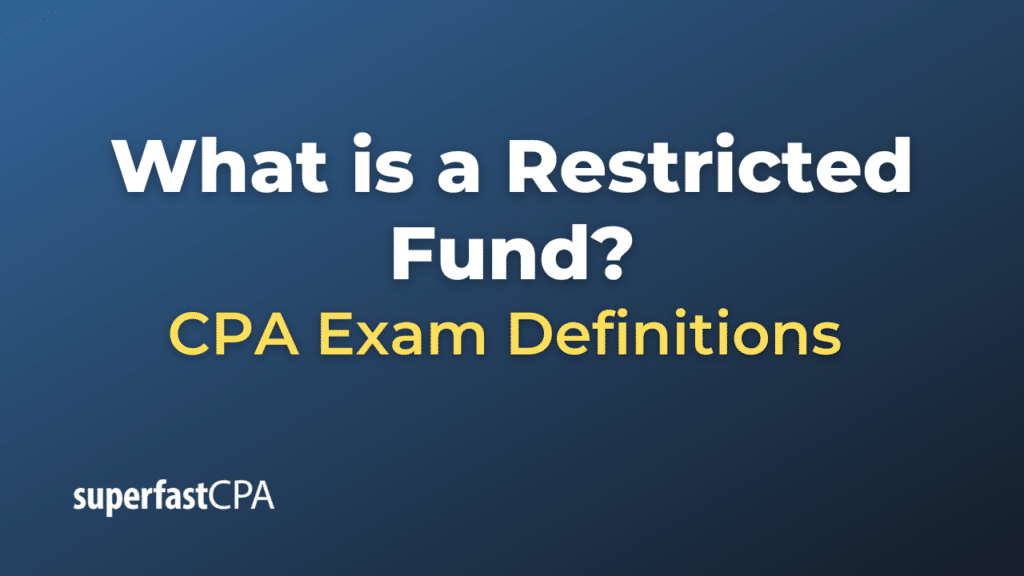Restricted Fund
A restricted fund refers to money or other assets that are set aside for a specific purpose and cannot be used for general or other unrelated activities. This restriction can be based on the wishes of a donor, grantor, or specific regulatory requirements. Restricted funds are commonly found in nonprofit organizations, where donors specify the use of their contributions.
There are two primary types of restricted funds:
- Temporarily Restricted Funds: These funds are restricted for a certain purpose or period. Once the purpose is fulfilled or the time restriction passes, the funds can be moved to the organization’s unrestricted fund. For example, a donor might contribute money to a university with the stipulation that it be used for a specific research project. Once the project is completed, any remaining funds might be reallocated.
- Permanently Restricted Funds: These funds have a perpetual restriction. Often, the principal amount is maintained, and only the income or interest generated by the principal is used for the organization’s activities. An endowment is a common example where the main fund remains untouched and only the earnings (like interest or dividends) are spent.
Why Restricted Funds Exist:
- Donor Wishes: A donor might wish to ensure that their donation is used for a specific purpose, like scholarships, research, or facility upgrades.
- Legal or Regulatory Requirements: Some grants or contributions may come with stipulations or legal requirements that dictate how the funds must be used.
- Long-term Goals: An organization might set up its own internal restricted funds to save for future projects or anticipated needs.
Financial Reporting:
When nonprofit organizations prepare their financial statements, they typically segregate their net assets into these categories:
- Unrestricted
- Temporarily Restricted
- Permanently Restricted
This separation ensures clarity for stakeholders about how much money is available for various purposes and what amounts are earmarked for specific uses.
Example of a Restricted Fund
Let’s delve into a fictional example involving a nonprofit organization and a generous donor to illustrate the concept of a restricted fund.
Nonprofit Organization: Green Future Foundation (GFF)
Background: Green Future Foundation is dedicated to environmental education and tree planting initiatives in urban areas. They operate various programs, from school workshops about environmental responsibility to monthly tree planting events.
Scenario:
- Major Donation: Mrs. Clara Evans, a wealthy environmentalist, donates $500,000 to GFF. However, she doesn’t just hand over the money without conditions. She specifies that her donation must be used exclusively for tree planting initiatives and not for administrative costs or any other programs.
- Establishing the Restricted Fund: Respecting Mrs. Evans’ wishes, GFF sets up the “Clara Evans Tree Planting Fund.” This is a restricted fund, separate from the general fund of GFF. The money in this fund can only be used to purchase saplings, maintain planted trees, and cover related costs.
- Annual Spending: Each year, GFF uses a portion of the “Clara Evans Tree Planting Fund” to plant thousands of trees in various urban neighborhoods. They carefully document all expenses to ensure they strictly adhere to the purpose specified by Mrs. Evans.
- Reporting: When GFF prepares its annual financial report, the organization shows the “Clara Evans Tree Planting Fund” as a restricted fund in its financial statements, clearly separating it from its unrestricted funds and other resources. This transparency ensures that stakeholders, including donors like Mrs. Evans, can see how the money is being utilized and confirms that the organization respects donor-imposed restrictions.
- A Few Years Later: After five years, GFF has spent $300,000 from the restricted fund, leaving $200,000 remaining for future tree-planting initiatives. Over these years, thanks to Mrs. Evans’ donation, the organization has planted over 50,000 trees, contributing significantly to urban greenery and cleaner air.
This example underscores the importance of restricted funds in ensuring donor wishes are honored. It also emphasizes the accountability nonprofits have in managing and reporting these specific funds appropriately.













